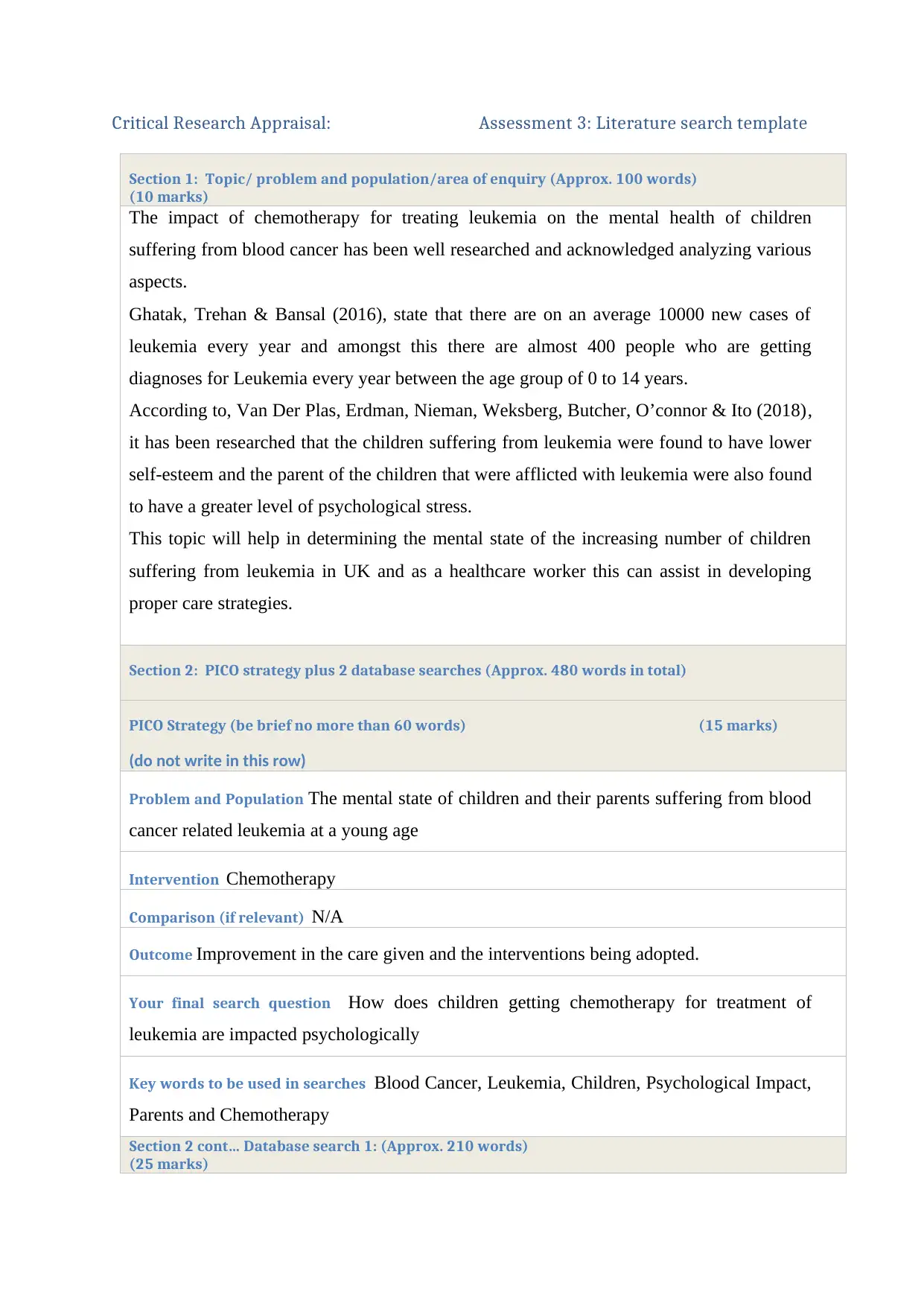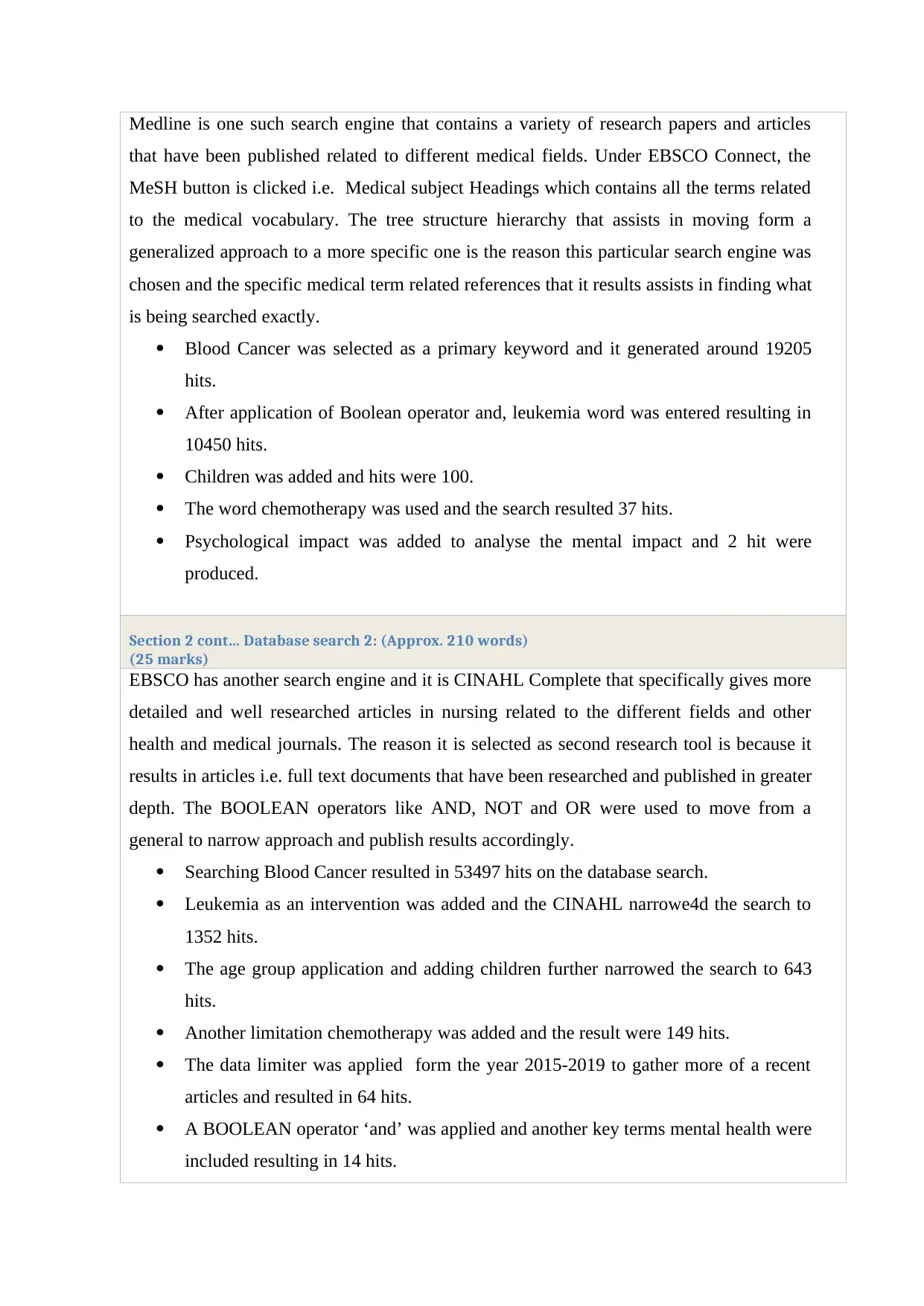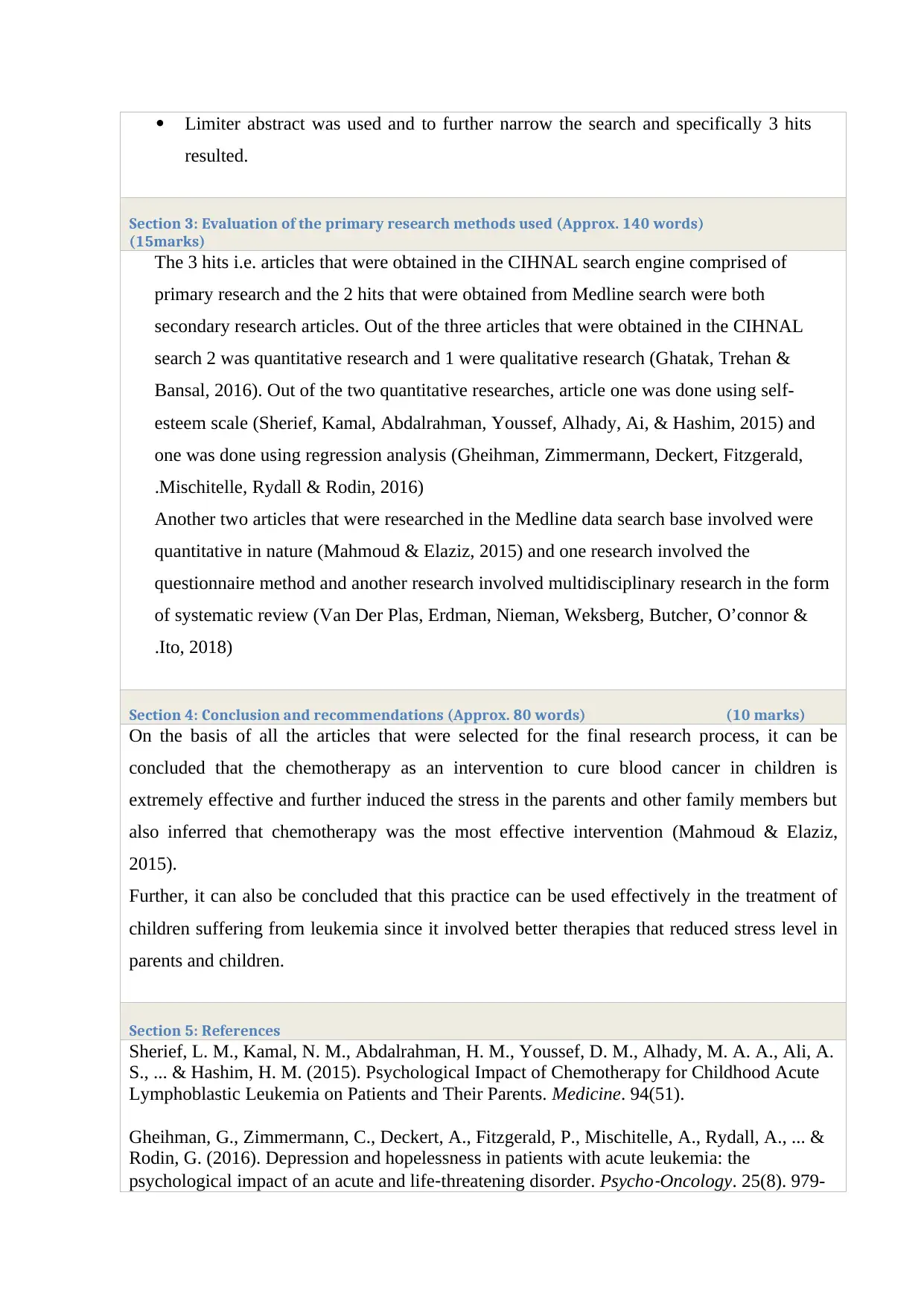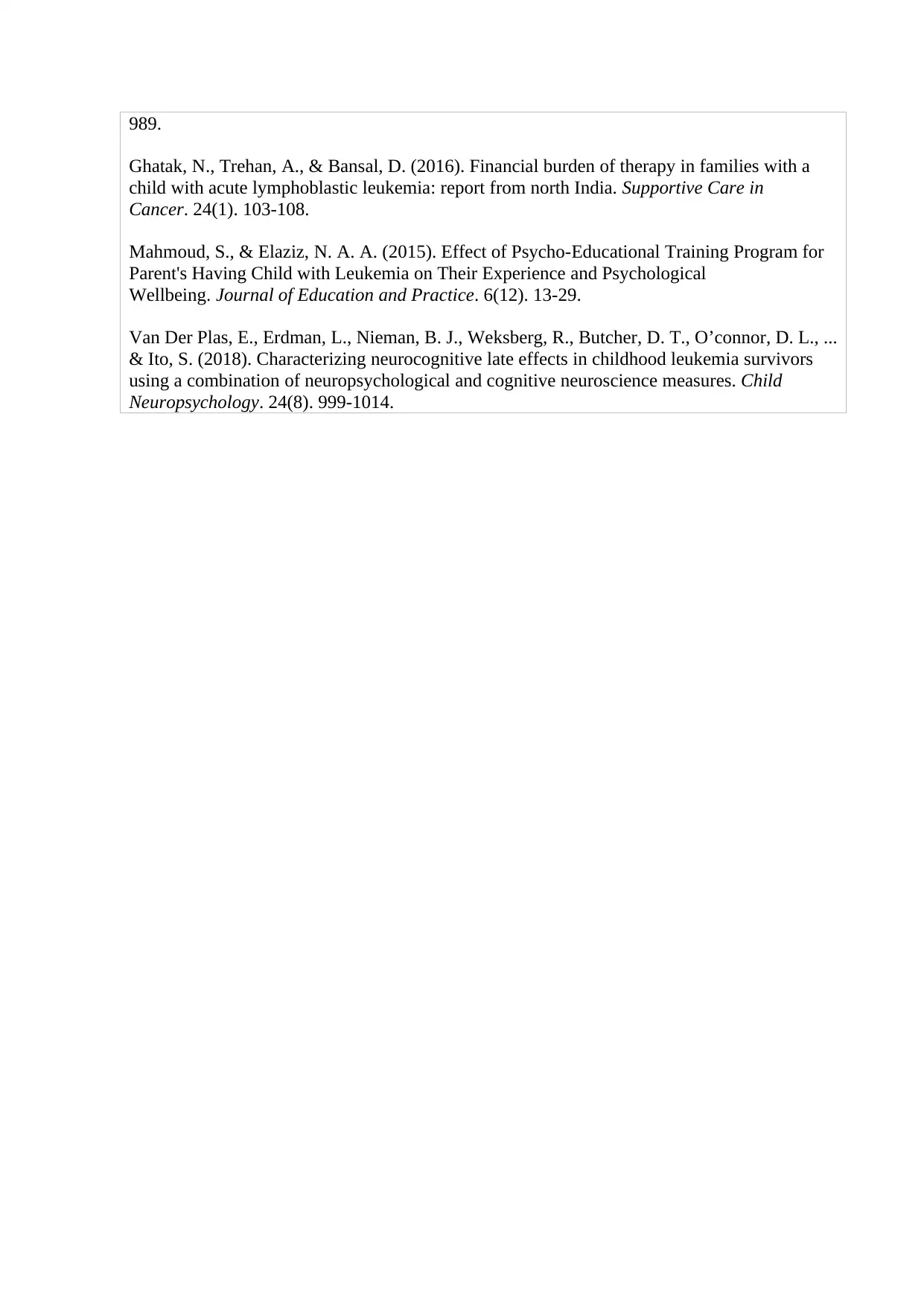Assessment 3: Impact of Chemotherapy on Childhood Leukemia
VerifiedAdded on 2023/01/18
|4
|1341
|32
Report
AI Summary
This report critically appraises the impact of chemotherapy on the mental health of children diagnosed with leukemia, focusing on the psychological effects on both children and their parents. The research utilizes a PICO strategy to formulate a focused question and conducts database searches on Medline and CINAHL to gather relevant literature. The report evaluates the primary research methods, identifying quantitative and qualitative studies, including those employing self-esteem scales and regression analysis. Finally, the report draws conclusions from the selected articles, highlighting the effectiveness of chemotherapy as an intervention while also acknowledging the stress it places on families, and offers recommendations for improved care strategies. The references cited include studies exploring psychological impacts, financial burdens, and psycho-educational programs. The report aims to provide a comprehensive overview of the current research landscape regarding the mental health of children with leukemia undergoing chemotherapy.

Critical Research Appraisal: Assessment 3: Literature search template
Section 1: Topic/ problem and population/area of enquiry (Approx. 100 words)
(10 marks)
The impact of chemotherapy for treating leukemia on the mental health of children
suffering from blood cancer has been well researched and acknowledged analyzing various
aspects.
Ghatak, Trehan & Bansal (2016), state that there are on an average 10000 new cases of
leukemia every year and amongst this there are almost 400 people who are getting
diagnoses for Leukemia every year between the age group of 0 to 14 years.
According to, Van Der Plas, Erdman, Nieman, Weksberg, Butcher, O’connor & Ito (2018),
it has been researched that the children suffering from leukemia were found to have lower
self-esteem and the parent of the children that were afflicted with leukemia were also found
to have a greater level of psychological stress.
This topic will help in determining the mental state of the increasing number of children
suffering from leukemia in UK and as a healthcare worker this can assist in developing
proper care strategies.
Section 2: PICO strategy plus 2 database searches (Approx. 480 words in total)
PICO Strategy (be brief no more than 60 words) (15 marks)
(do not write in this row)
Problem and Population The mental state of children and their parents suffering from blood
cancer related leukemia at a young age
Intervention Chemotherapy
Comparison (if relevant) N/A
Outcome Improvement in the care given and the interventions being adopted.
Your final search question How does children getting chemotherapy for treatment of
leukemia are impacted psychologically
Key words to be used in searches Blood Cancer, Leukemia, Children, Psychological Impact,
Parents and Chemotherapy
Section 2 cont… Database search 1: (Approx. 210 words)
(25 marks)
Section 1: Topic/ problem and population/area of enquiry (Approx. 100 words)
(10 marks)
The impact of chemotherapy for treating leukemia on the mental health of children
suffering from blood cancer has been well researched and acknowledged analyzing various
aspects.
Ghatak, Trehan & Bansal (2016), state that there are on an average 10000 new cases of
leukemia every year and amongst this there are almost 400 people who are getting
diagnoses for Leukemia every year between the age group of 0 to 14 years.
According to, Van Der Plas, Erdman, Nieman, Weksberg, Butcher, O’connor & Ito (2018),
it has been researched that the children suffering from leukemia were found to have lower
self-esteem and the parent of the children that were afflicted with leukemia were also found
to have a greater level of psychological stress.
This topic will help in determining the mental state of the increasing number of children
suffering from leukemia in UK and as a healthcare worker this can assist in developing
proper care strategies.
Section 2: PICO strategy plus 2 database searches (Approx. 480 words in total)
PICO Strategy (be brief no more than 60 words) (15 marks)
(do not write in this row)
Problem and Population The mental state of children and their parents suffering from blood
cancer related leukemia at a young age
Intervention Chemotherapy
Comparison (if relevant) N/A
Outcome Improvement in the care given and the interventions being adopted.
Your final search question How does children getting chemotherapy for treatment of
leukemia are impacted psychologically
Key words to be used in searches Blood Cancer, Leukemia, Children, Psychological Impact,
Parents and Chemotherapy
Section 2 cont… Database search 1: (Approx. 210 words)
(25 marks)
Paraphrase This Document
Need a fresh take? Get an instant paraphrase of this document with our AI Paraphraser

Medline is one such search engine that contains a variety of research papers and articles
that have been published related to different medical fields. Under EBSCO Connect, the
MeSH button is clicked i.e. Medical subject Headings which contains all the terms related
to the medical vocabulary. The tree structure hierarchy that assists in moving form a
generalized approach to a more specific one is the reason this particular search engine was
chosen and the specific medical term related references that it results assists in finding what
is being searched exactly.
Blood Cancer was selected as a primary keyword and it generated around 19205
hits.
After application of Boolean operator and, leukemia word was entered resulting in
10450 hits.
Children was added and hits were 100.
The word chemotherapy was used and the search resulted 37 hits.
Psychological impact was added to analyse the mental impact and 2 hit were
produced.
Section 2 cont… Database search 2: (Approx. 210 words)
(25 marks)
EBSCO has another search engine and it is CINAHL Complete that specifically gives more
detailed and well researched articles in nursing related to the different fields and other
health and medical journals. The reason it is selected as second research tool is because it
results in articles i.e. full text documents that have been researched and published in greater
depth. The BOOLEAN operators like AND, NOT and OR were used to move from a
general to narrow approach and publish results accordingly.
Searching Blood Cancer resulted in 53497 hits on the database search.
Leukemia as an intervention was added and the CINAHL narrowe4d the search to
1352 hits.
The age group application and adding children further narrowed the search to 643
hits.
Another limitation chemotherapy was added and the result were 149 hits.
The data limiter was applied form the year 2015-2019 to gather more of a recent
articles and resulted in 64 hits.
A BOOLEAN operator ‘and’ was applied and another key terms mental health were
included resulting in 14 hits.
that have been published related to different medical fields. Under EBSCO Connect, the
MeSH button is clicked i.e. Medical subject Headings which contains all the terms related
to the medical vocabulary. The tree structure hierarchy that assists in moving form a
generalized approach to a more specific one is the reason this particular search engine was
chosen and the specific medical term related references that it results assists in finding what
is being searched exactly.
Blood Cancer was selected as a primary keyword and it generated around 19205
hits.
After application of Boolean operator and, leukemia word was entered resulting in
10450 hits.
Children was added and hits were 100.
The word chemotherapy was used and the search resulted 37 hits.
Psychological impact was added to analyse the mental impact and 2 hit were
produced.
Section 2 cont… Database search 2: (Approx. 210 words)
(25 marks)
EBSCO has another search engine and it is CINAHL Complete that specifically gives more
detailed and well researched articles in nursing related to the different fields and other
health and medical journals. The reason it is selected as second research tool is because it
results in articles i.e. full text documents that have been researched and published in greater
depth. The BOOLEAN operators like AND, NOT and OR were used to move from a
general to narrow approach and publish results accordingly.
Searching Blood Cancer resulted in 53497 hits on the database search.
Leukemia as an intervention was added and the CINAHL narrowe4d the search to
1352 hits.
The age group application and adding children further narrowed the search to 643
hits.
Another limitation chemotherapy was added and the result were 149 hits.
The data limiter was applied form the year 2015-2019 to gather more of a recent
articles and resulted in 64 hits.
A BOOLEAN operator ‘and’ was applied and another key terms mental health were
included resulting in 14 hits.

Limiter abstract was used and to further narrow the search and specifically 3 hits
resulted.
Section 3: Evaluation of the primary research methods used (Approx. 140 words)
(15marks)
The 3 hits i.e. articles that were obtained in the CIHNAL search engine comprised of
primary research and the 2 hits that were obtained from Medline search were both
secondary research articles. Out of the three articles that were obtained in the CIHNAL
search 2 was quantitative research and 1 were qualitative research (Ghatak, Trehan &
Bansal, 2016). Out of the two quantitative researches, article one was done using self-
esteem scale (Sherief, Kamal, Abdalrahman, Youssef, Alhady, Ai, & Hashim, 2015) and
one was done using regression analysis (Gheihman, Zimmermann, Deckert, Fitzgerald,
Mischitelle, Rydall & Rodin, 2016).
Another two articles that were researched in the Medline data search base involved were
quantitative in nature (Mahmoud & Elaziz, 2015) and one research involved the
questionnaire method and another research involved multidisciplinary research in the form
of systematic review (Van Der Plas, Erdman, Nieman, Weksberg, Butcher, O’connor &
Ito, 2018).
Section 4: Conclusion and recommendations (Approx. 80 words) (10 marks)
On the basis of all the articles that were selected for the final research process, it can be
concluded that the chemotherapy as an intervention to cure blood cancer in children is
extremely effective and further induced the stress in the parents and other family members but
also inferred that chemotherapy was the most effective intervention (Mahmoud & Elaziz,
2015).
Further, it can also be concluded that this practice can be used effectively in the treatment of
children suffering from leukemia since it involved better therapies that reduced stress level in
parents and children.
Section 5: References
Sherief, L. M., Kamal, N. M., Abdalrahman, H. M., Youssef, D. M., Alhady, M. A. A., Ali, A.
S., ... & Hashim, H. M. (2015). Psychological Impact of Chemotherapy for Childhood Acute
Lymphoblastic Leukemia on Patients and Their Parents. Medicine. 94(51).
Gheihman, G., Zimmermann, C., Deckert, A., Fitzgerald, P., Mischitelle, A., Rydall, A., ... &
Rodin, G. (2016). Depression and hopelessness in patients with acute leukemia: the
psychological impact of an acute and life‐threatening disorder. Psycho
‐Oncology. 25(8). 979-
resulted.
Section 3: Evaluation of the primary research methods used (Approx. 140 words)
(15marks)
The 3 hits i.e. articles that were obtained in the CIHNAL search engine comprised of
primary research and the 2 hits that were obtained from Medline search were both
secondary research articles. Out of the three articles that were obtained in the CIHNAL
search 2 was quantitative research and 1 were qualitative research (Ghatak, Trehan &
Bansal, 2016). Out of the two quantitative researches, article one was done using self-
esteem scale (Sherief, Kamal, Abdalrahman, Youssef, Alhady, Ai, & Hashim, 2015) and
one was done using regression analysis (Gheihman, Zimmermann, Deckert, Fitzgerald,
Mischitelle, Rydall & Rodin, 2016).
Another two articles that were researched in the Medline data search base involved were
quantitative in nature (Mahmoud & Elaziz, 2015) and one research involved the
questionnaire method and another research involved multidisciplinary research in the form
of systematic review (Van Der Plas, Erdman, Nieman, Weksberg, Butcher, O’connor &
Ito, 2018).
Section 4: Conclusion and recommendations (Approx. 80 words) (10 marks)
On the basis of all the articles that were selected for the final research process, it can be
concluded that the chemotherapy as an intervention to cure blood cancer in children is
extremely effective and further induced the stress in the parents and other family members but
also inferred that chemotherapy was the most effective intervention (Mahmoud & Elaziz,
2015).
Further, it can also be concluded that this practice can be used effectively in the treatment of
children suffering from leukemia since it involved better therapies that reduced stress level in
parents and children.
Section 5: References
Sherief, L. M., Kamal, N. M., Abdalrahman, H. M., Youssef, D. M., Alhady, M. A. A., Ali, A.
S., ... & Hashim, H. M. (2015). Psychological Impact of Chemotherapy for Childhood Acute
Lymphoblastic Leukemia on Patients and Their Parents. Medicine. 94(51).
Gheihman, G., Zimmermann, C., Deckert, A., Fitzgerald, P., Mischitelle, A., Rydall, A., ... &
Rodin, G. (2016). Depression and hopelessness in patients with acute leukemia: the
psychological impact of an acute and life‐threatening disorder. Psycho
‐Oncology. 25(8). 979-
⊘ This is a preview!⊘
Do you want full access?
Subscribe today to unlock all pages.

Trusted by 1+ million students worldwide

989.
Ghatak, N., Trehan, A., & Bansal, D. (2016). Financial burden of therapy in families with a
child with acute lymphoblastic leukemia: report from north India. Supportive Care in
Cancer. 24(1). 103-108.
Mahmoud, S., & Elaziz, N. A. A. (2015). Effect of Psycho-Educational Training Program for
Parent's Having Child with Leukemia on Their Experience and Psychological
Wellbeing. Journal of Education and Practice. 6(12). 13-29.
Van Der Plas, E., Erdman, L., Nieman, B. J., Weksberg, R., Butcher, D. T., O’connor, D. L., ...
& Ito, S. (2018). Characterizing neurocognitive late effects in childhood leukemia survivors
using a combination of neuropsychological and cognitive neuroscience measures. Child
Neuropsychology. 24(8). 999-1014.
Ghatak, N., Trehan, A., & Bansal, D. (2016). Financial burden of therapy in families with a
child with acute lymphoblastic leukemia: report from north India. Supportive Care in
Cancer. 24(1). 103-108.
Mahmoud, S., & Elaziz, N. A. A. (2015). Effect of Psycho-Educational Training Program for
Parent's Having Child with Leukemia on Their Experience and Psychological
Wellbeing. Journal of Education and Practice. 6(12). 13-29.
Van Der Plas, E., Erdman, L., Nieman, B. J., Weksberg, R., Butcher, D. T., O’connor, D. L., ...
& Ito, S. (2018). Characterizing neurocognitive late effects in childhood leukemia survivors
using a combination of neuropsychological and cognitive neuroscience measures. Child
Neuropsychology. 24(8). 999-1014.
1 out of 4
Your All-in-One AI-Powered Toolkit for Academic Success.
+13062052269
info@desklib.com
Available 24*7 on WhatsApp / Email
![[object Object]](/_next/static/media/star-bottom.7253800d.svg)
Unlock your academic potential
Copyright © 2020–2025 A2Z Services. All Rights Reserved. Developed and managed by ZUCOL.

